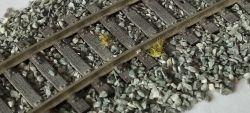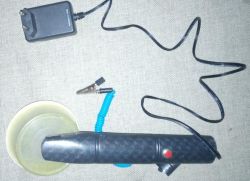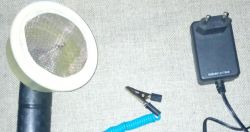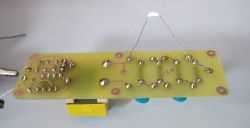FAQ
TL;DR: A 12 V supply, NE555 at 12 kHz drives a printer fly-back to yield 1.4 kV DC, stepped to ~6 kV for “dense, upright grass in 2.5 mm length” [Elektroda, Justyniunia, post #19488854] “Single-kilovolt is enough” [Elektroda, Justyniunia, post #19489228] The design uses cheap printer parts and a six-stage Cockcroft-Walton multiplier.
Why it matters: Clean kilovolt fields lock fibres upright, saving hobbyists €50-€100 versus buying a commercial tool.
Quick Facts
• Drive signal: 12 kHz, 60 % duty cycle from NE555 [Elektroda, Justyniunia, post #19488854]
• Raw HV: 1.4 kV DC at 12 V input, measured with Sonel CMM10 [Elektroda, Justyniunia, post #19488854]
• Multiplier: 6-stage, 6 kV/5 mA diodes + 3.3 nF/6 kV capacitors [Elektroda, Justyniunia, post #19488854]
• Commercial reference: Woodland Scenics Static King delivers ~15 kV, <0.5 mA (*Product Sheet*)
• Safe gap: Coat PCB with insulating varnish to stop surface tracking above 4 kV [Elektroda, 398216, post #19489148]
What is an electrostatic grass planter and how does it work?
A planter (flocker) charges nylon or rayon fibres so they behave like tiny dipoles. A kilovolt field pulls each fibre perpendicular to a glue-coated surface, mimicking real grass [Elektroda, Justyniunia, post #19489228]
Which electronic parameters define the DIY unit in the thread?
The oscillator runs at 12 kHz with a 60 % duty cycle. A BD135 keys a printer fly-back that produces 1.4 kV DC, later multiplied to roughly 6 kV through a six-stage Cockcroft-Walton chain [Elektroda, Justyniunia, post #19488854]
Why choose an NE555 plus BD135?
The NE555 delivers a stable square wave and allows easy frequency adjustment. The BD135 handles the 200–300 mA primary current and withstands the transformer’s inductive spikes, keeping parts cost under €2 [Typical BD135 datasheet].
How much voltage do I actually need?
Fields above 1 kV already lift 2–3 mm fibres. Tests show ~6 kV gives dense coverage, while commercial units ship with 15 kV for 12 mm grass [Woodland Scenics, Static King]. “Single-kilovolt is enough” for H0 scenery [Elektroda, Justyniunia, post #19489228]
Does high-voltage polarity matter?
Polarity has no visible effect on fibre orientation; either electrode can be ground [Elektroda, Justyniunia, post #19494263]
What happens if the voltage is too high?
Above ~8 kV, fibres blow off the sieve and static arcs form. With a 10-stage multiplier the author saw sparks between components—a classic edge-case failure [Elektroda, Justyniunia, post #19489228]
How should I insulate the multiplier board?
Wash off flux residues, dry thoroughly, then spray both sides with insulating varnish. Skipping this step leads to surface tracking and spectacular punctures, as seen in a school-laser PSU [Elektroda, 398216, post #19489148]
Can the same circuit work for DIY powder coating?
Yes, but coating needs 10–25 kV so you would add more stages and a current-limiting resistor. Ensure the gun, not the user, is at high potential to avoid dangerous shocks [OSHA, 2021].
Which decoupling capacitors are recommended for the NE555?
Place 100 nF from VCC to ground and 10 nF from pin 5 to ground. The latter stabilises threshold noise, even if the circuit appears to work without it [Elektroda, ArturAVS, post #19489627]
Is the 10-stage multiplier worth building?
No. It arced over at only 12 V input, damaging components. The six-stage version already delivers a stable 6 kV and cleaner fibres [Elektroda, Justyniunia, post #19489228]
What safety rules apply when playing with kilovolts?
- Power from an isolated wall adapter.
- Limit output current with ≥100 MΩ resistor.
- Never touch the sieve until fully discharged.
A 5 mA shock can stop respiration [IEC 60479-1].
How do modular layouts help small apartments?
The author splits his 2.5 m station into three modules that slide under a bed, proving H0 fits even in a flat [Elektroda, Justyniunia, post #19490385]
Where can I buy ready-made semaphores if I hate soldering SMD LEDs?
Options include Ostbahn DIY kits (~PLN 8), Hulacki plastic masts, Minikol metal blades, and Kluba premium brass (>PLN 100, long lead time) [Elektroda, Justyniunia, post #19490937] “Each product has its own market” [Elektroda, pikarel, post #19491425]
Quick 3-step guide: how to flock grass like the pros?
- Brush a thin PVA layer on the terrain.
- Fill the planter’s sieve, connect the ground clip to the glue zone.
- Hold the sieve 2–4 cm above and tap gently until coverage looks even. Let it dry, then vacuum excess. This 45-second routine copies factory machines [Elektroda, Justyniunia, post #19494263]











Comments
In my time, grass was made of sawdust painted green with a poster ... (after "planting" of course). There was also a nice way to make cobblestones, bricks, etc. surfaces - you put a piece of tulle on... [Read more]
Maybe a colleague describe what the WN generator has for grass in modeling? Because not everyone is so interested in it and there is no movie / description. [Read more]
I suggest you read about the Flock technique. This weed is a textile shearing. It is applied by means of an electric field to a surface covered with an adhesive. The fibers are attracted and electrified,... [Read more]
Can I ask for a diagram out of curiosity? I do not have much in common with modeling that does not fly, but it occurred to me whether this type of device is not suitable for powder coating. [Read more]
Please https://obrazki.elektroda.pl/8217376800_1624347075_thumb.jpg [Read more]
Maybe for this particular 555 application it is irrelevant but a decoupling capacitor between pin 5 and ground is recommended. [Read more]
Yes, input 5 should go through the capacitor to ground. It does not really matter here, at most the parameters will float a little. In some 555s you do not need to connect the 4, because it is pulled... [Read more]
Oh look! I have never found one like this and the 555 is such a universal system that I always have a dozen new ones in stock (THT and SMD from different manufacturers). [Read more]
Once, while making a colleague's board, I forgot to connect 4 to vcc on the PCB, he noticed this error, but it turned out that the system worked without any problems. He was also not sensitive to touching... [Read more]
I am curious what this garden looks like :D . I would like to play in H0 or something similar, but the area of the premises does not allow :-( . Maybe it was the CMOS version and the ESD diode on the... [Read more]
Then you can choose between TT and N. I started to play with HO, then (for housing reasons) I switched to TT until ... and I cured myself from spending money on something that only gave me fun. [Read more]
I live in a block of flats, I wanted a TT, but look at the geometrical layouts of TT and H0 tracks. TT Tillig is a crazy dream. Exit a parallel track from a turnout in the TT and H0 systems: https://obrazki.elektroda.pl/2831655300_1624381245_thumb.jpg... [Read more]
One of the reasons I switched to the TT was the lack of a HO selection. And the price ... all of this resulted in the choice of the TT. N'ka was just a misunderstanding ... It's just that then... [Read more]
A few years ago, with the help of one colleague from Poland, Piko produced the ST43 locomotive, it spread like hot cakes, today there are several, if not several, models of PKP locomotives in Piko's... [Read more]
My friend Zdzich offers a variety of model making, which he produces himself: http://hulacki.com/sklepmodelarski/10-modele-kolejowe-h0 Take a look, maybe you will like something from the offer, and the... [Read more]
Hello. Thank you, I know the products, hmm. Maybe yes: On the right a semaphore in H0, on the left Hulacki ... https://obrazki.elektroda.pl/8310450000_1624424425_thumb.jpg You can choose from: ... [Read more]
It's good that there is such a choice. A colleague designs these models himself, including molds for injection molding machines (I service the controllers, because some machines are quite old), so... [Read more]
Of course, each product has its own market and that's fine. There are many people among modelers who have no idea about electronics, for them assembling the semaphore by themselves is a piece of cake,... [Read more]
We sow the grass with a seeder. We plant with a planter. Trolls, let me remind you that we solder with a soldering iron and weld with a welder. Plus, this planter is pretty cool. [Read more]